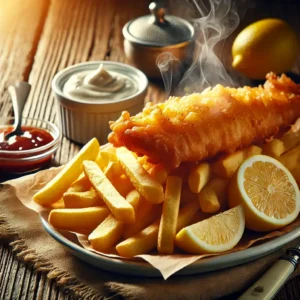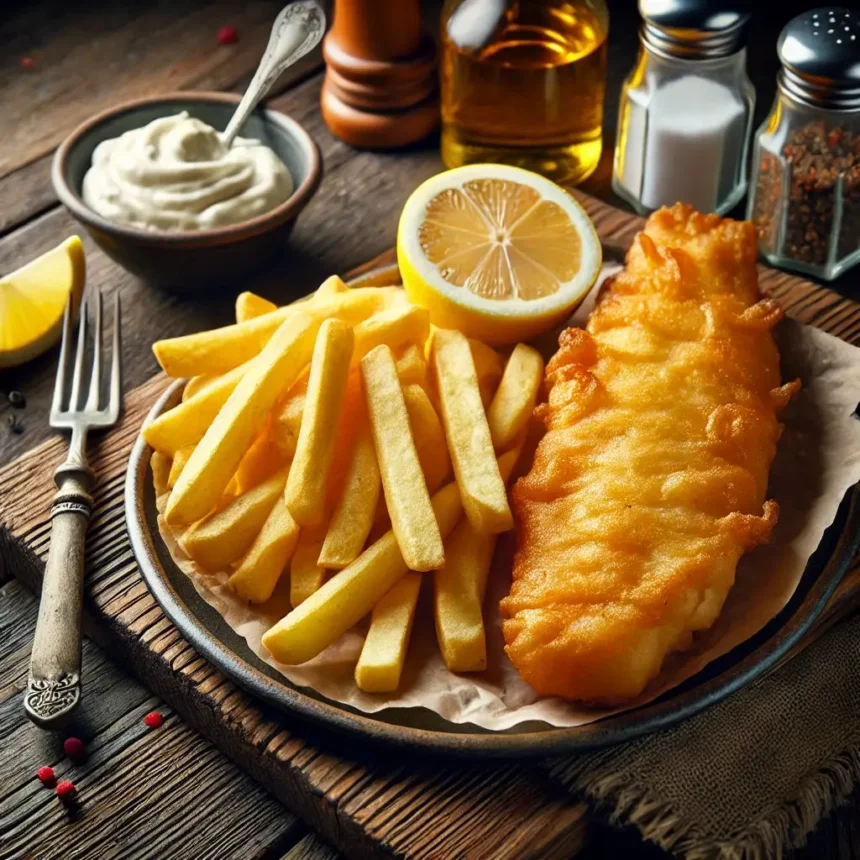Introduction to Fish and Chips
Fish and chips, a worldwide dish, is a beloved British meal. Combining crispy battered fish with chunky fried potatoes, this meal has stood the test of time. Whether eating it by the seaside or grabbing a quick takeaway, fish and chips offer a simple yet satisfying experience.
This article will explore fish and chips’ history, recipe, and cultural significance. You’ll also learn to make them home and discover why they are favorites.
A Brief History of Fish and Chips
The origins of fish and chips can be traced back to the 19th century in Britain. The fish component of the dish comes from Jewish immigrants who introduced fried fish to England. Chips, or thick-cut fries, were added later, creating the iconic dish we know Today. Fish and chips became a staple meal during the Industrial Revolution, providing cheap and filling food for workers.
By the mid-20th century, fish and chips were firmly established as a national dish in the U.K. Today, it remains a go-to meal for many worldwide, from small seaside shops to high-end restaurants.
The Perfect Fish for Fish and Chips
Choosing the right fish is vital to making good fish and_chipss. Traditionally, cod and haddock are the most common choices. Both types of fish have a mild flavor and flaky texture, perfect for battering and frying. Cod, in particular, is loved for its thick fillets, while haddock offers a slightly sweeter taste.
Other Fish Options:
- Pollock: A more sustainable option, often used as a substitute for cod.
- Hake: Another white fish with a flaky texture, making it a good alternative.
- Tilapia: Widely available and affordable, this fish works well in fish and_chipss.
How to Make Crispy Fish Batter
The crispy coating is what makes fish and_chipss truly special. A light and crunchy batter is critical. The most common batter uses simple ingredients like flour, baking powder, and cold water. Some people add beer to the batter for a crispy texture and flavor.
Basic Fish Batter Recipe:
- 1 cup of flour
- One teaspoon of baking powder
- 1 cup of cold water (or beer for a beer batter)
- Salt to taste
Mix the ingredients until smooth, and dip the fish fillets in the batter before frying them in hot oil. The result is a golden, crunchy crust with tender fish inside.
The Best Chips to Pair with Fish
Chips, known as fries in some parts of the world, are the perfect companion to battered fish. Unlike thin, fast-food-style fries, the chips served with fish are thick-cut and fried twice for the best results.
How to Make the Perfect Chips:
- Peel and cut potatoes into thick slices.
- Soak the potatoes in cold water for 30 minutes to remove excess starch.
- Par-boil the potatoes for a few minutes.
- Drain and dry the potatoes before frying them at a lower temperature (around 150°C) until soft.
- Finally, fry the chips again at a higher temperature (around 180°C) for a crispy finish.
This double-fry method ensures the chips are soft inside and crispy outside.
Condiments and Side Dishes
Fish and_chipss are often served with a variety of condiments and sides. Popular options include:
- Vinegar: Many people drizzle malt vinegar over fish and_chipss for added tang.
- Tartar Sauce: A creamy sauce made from mayonnaise, capers, and pickles, perfect for dipping.
- Lemon Wedge: Squeezing fresh lemon over the fish adds a bright, zesty flavor.
- Mushy Peas: This classic British dish mashes cooked peas with butter and mint.
- Pickled Onions: A sharp, tangy addition to the meal.
These sides and condiments enhance the dish’s flavor, making it even more enjoyable.
The Global Popularity of Fish and Chips
While fish and_chipss originated in Britain, they have gained popularity worldwide. In Australia, fish and_chipss are a popular seaside meal. In New Zealand, the dish is a national favorite. Even in the United States, many restaurants offer their versions of fish and_chipss.
Health Benefits and Considerations
While fish and_chipss are delicious, they are often fried, which increases their calories. However, fish itself is an excellent source of protein, omega-3 fatty acids, and vitamins. Choosing healthier cooking methods, such as oven-baking the fish and air-frying the chips, can make this dish a more nutritious option.
Fish and Chips Recipe: A Step-by-Step Guide
Here’s how to make fish and_chipss at home:
Ingredients:
- Two large white fish fillets (cod, haddock, or similar)
- Four large potatoes
- 1 cup flour
- One teaspoon of baking powder
- 1 cup cold water (or beer)
- Oil for frying
- Salt and pepper to taste
- Vinegar, tartar sauce, or lemon for serving
Instructions:
- Prepare the batter by mixing flour, baking powder, and water until smooth.
- Peel and cut potatoes into thick slices, then soak them in water.
- Heat oil in a deep fryer or large pan.
- Par-boil the potatoes for a few minutes, drain, and fry at a low temperature.
- Coat the fish in batter and fry until golden brown.
- Fry the chips a second time at a higher temperature until crispy.
- Serve the fish and chipss with your choice of condiments.
Enjoy your homemade fish and_chipss!

FAQs About Fish and Chips
Q: Can I use frozen fish for fish and_chips?
A: You can use frozen fish, but fresh fish will give you a better texture and taste.
Q: What type of oil is best for frying fish and_chips?
A: Vegetable or sunflower oil works well because they have high smoke points.
Q: How do I keep the fish batter crispy?
A: Ensure the oil is hot enough, and avoid overcrowding the pan. The cold batter also helps achieve a crispier result.
Q: Can I bake the fish instead of frying?
A: You can bake it for a healthier option, but it won’t have the same crispy texture.
Q: Are fish and_chips gluten-free?
A: You can make them gluten-free by using gluten-free flour for the batter.
Conclusion
Fish and_chipss remain a beloved dish worldwide. Their simplicity and bold flavors have kept them a favorite for generations. Whether enjoying them at the seaside or recreating them at home, fish and_chipss always offer a satisfying meal.





